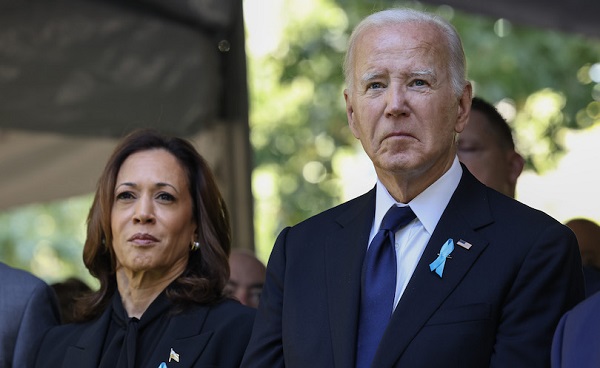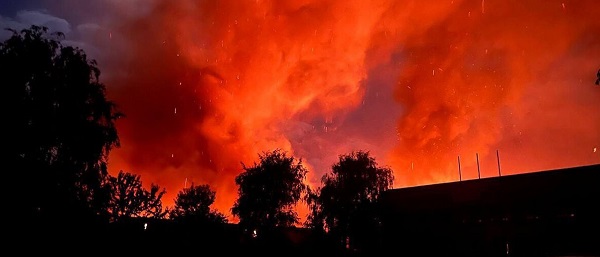conflict
How Biden-Harris blocked a Russia-Ukraine peace deal

From LifeSiteNews
By Bob Marshall
While a peace deal between Russia and Ukraine seemed likely weeks into the war, we must remember when U.S. Defense Secretary Lloyd Austin admitted in April 2022 that America’s goal wasn’t peace, but weakening Russia.
Western media sources documented Ukraine and Russia peace proposals during the first weeks of the conflict in February 2022. Reuters noted, “Ukraine wants peace and is ready for talks with Russia, including on neutral status regarding NATO, Ukrainian presidential advisor Mykhailo Podolyak told Reuters. … ‘If talks are possible, they should be held. If Moscow … want[s] to hold talks, including on neutral status, we are not afraid of this. … Our readiness for dialogue is part of our persistent pursuit of peace.’”
Reuters printed a follow-up 14 hours later: “The Russian and Ukrainian governments … signaled an openness to negotiations even as authorities in Kyiv urged citizens to help defend the capital from advancing Russian forces. … Ukraine and Russia will consult in the coming hours on a time and place for talks.” Ukrainian President Volodymyr Zelensky’s spokesman said, “Ukraine was and remains ready to talk about a ceasefire and peace. … We agreed to the proposal of the President of the Russian Federation.” But as Reuters went on to note, “U.S. State Department spokesman Ned Price said Russia’s offer was an attempt to conduct diplomacy ‘at the barrel of a gun,’ and that President Vladimir Putin’s military must stop bombing Ukraine if it was serious about negotiations.”
In Foreign Affairs, Fiona Hill and Angela Stent wrote: “According to multiple former senior U.S. officials we spoke with, in April 2022, Russian and Ukrainian negotiators appeared to have tentatively agreed on the outlines of a negotiated interim settlement: Russia would withdraw to its position on February 23, when it controlled part of the Donbas region and all of Crimea, and … Ukraine would promise not to seek NATO membership and instead receive security guarantees from a number of countries.”
The British Financial Times reported in March 2022: “Israel’s Prime Minister Naftali Bennett has been the primary international mediator. … Mykhailo Podolyak, a senior adviser to Zelensky told the Financial Times that any deal would involve: ‘the troops of the Russian Federation … leaving the territory of Ukraine’ captured since the invasion began on February 24. … Ukraine would maintain its armed forces but would be obliged to stay outside military alliances such as NATO and refrain from hosting foreign military bases on its territory.”
The Times report continued, “Putin’s press secretary Dmitry Peskov told reporters … that neutrality for Ukraine based on the status of Austria or Sweden was a possibility. ‘This option is really being discussed now, and is one that can be considered neutral.’ … Sergei Lavrov, Russia’s foreign minister, said that ‘absolutely specific wordings’ were ‘close to being agreed’ in the negotiations. … The putative deal also included … rights for the Russian language in Ukraine, where it is widely spoken though Ukrainian is the only official language. … The biggest sticking point remains Russia’s demand that Ukraine recognize its 2014 annexation of Crimea and the independence of two separatist statelets in the eastern Donbas border region. Ukraine … was willing to compartmentalise the issue.”
Ukrainska Pravda reported: “[T]he Prime Minister of the United Kingdom Boris Johnson, who appeared in the capital almost without warning, brought two simple messages. The first is that Putin is a war criminal, he should be pressured, not negotiated with. And the second is that even if Ukraine is ready to sign some agreements on guarantees with Putin, they are not. Johnson’s position was that the collective West … now felt that Putin was not really as powerful as they had previously imagined, and that here was a chance to ‘press him.’ Three days after Johnson left for Britain, Putin went public and said talks with Ukraine ‘had turned into a dead end.’”
U.S. changes war aims
Originally, NATO and the U.S. claimed that they were helping Ukraine simply so that it could retain its sovereignty and defend its territory. But U.S. Defense Secretary Lloyd Austin announced at an April 2022 press conference in Poland that the U.S. wants to see “Russia weakened to the degree that it can’t do the kinds of things that it has done in invading Ukraine,” adding that with “the right equipment” and the “right support” Ukraine could win over Russia.
But logically, weakening Russia was significantly less likely to happen if the Ukraine war ended in April 2022. Pentagon officials met in mid-April in a classified meeting with eight large defense contractors including Raytheon Company and Lockheed Martin Corporation for discussion on resupplying weapons to Ukraine to prepare for a longer war with Russia.
Charles Freeman, past U.S. Ambassador to Saudi Arabia, noted that “from the very beginning the solution has been obvious, which is some variant of the Austrian State Treaty of 1955, meaning a guaranteed independence in return for … decent treatment of minorities inside the guaranteed state; and … neutrality for the guaranteed state.”
Prolonging the war for whatever reason is not a criteria for conducting a “just war.” Extending the war would mean many more grandchildren, children, husbands, fathers, sons, brothers, cousins, and civilians would be killed, wounded, or maimed among both Ukrainian and Russian casualties. Surely, the Russian and Ukrainian families and friends of those killed, wounded, or injured as well as owners of businesses destroyed in the war, when reflecting on their losses, would have thought that accepting the initial agreements were much better than what has happened since.
American columnist Pat Buchanan pointed out that “President Joe Biden almost hourly promises, ‘We are not going to war in Ukraine.’ Why would he then not readily rule out NATO membership for Ukraine, which would require us to do something Biden himself says we Americans, for our own survival, should never do: go to war with Russia?”
Russia-Ukraine accidental nuclear war
Putin warned that if the U.S. or NATO gave permission for Ukraine to use western missiles to strike deeply into Russia, that would radically change the current war because while choosing targets inside Russia can be done by Ukraine military personnel, getting the missiles to hit the long range Russian targets depends directly on western control guiding and directing the missiles. Putin said, “[I]t will mean nothing less than the direct participation of NATO countries, the United States, and European countries, in the war in Ukraine.”
Dmitry Peskov, Russia’s press representative, said that Putin’s statement was, “extremely clear, unambiguous and does not allow for any double readings. We have no doubt that it has reached its intended recipients.” Biden-Harris have backed away for now.
America was founded on the belief in Providence, which consists of the Creator acting within the sphere of human history. Similarly, many citizens of Austria, a Catholic country, placed their trust in Divine Providence by engaging in a multi-year prayer crusade to free Austria from the Soviet military occupation that occurred after World War II. It included the Catholic Rosary organized by the Austrian Franciscan priest, Fr. Petrus Pavlicek, who believed that, “Peace is a gift of God, not the work of politicians.”
The effort to secure Austrian neutrality succeeded on May 15, 1955 with representatives of the Soviet Union, Great Britain, the United States, and France signing a treaty under which all military occupation forces from WWII would withdraw from Austria if it would maintain neutrality. Austria has not joined NATO and has remained neutral to this day.
Unlike Biden-Harris, President Donald Trump and his running mate J.D. Vance do not have to reverse themselves on the prosecution of the Russia-Ukraine war. Barron’s reported in October that Donald Trump told Ukraine President Zelenskyy that the war never needed to happen, and that The Wall Street Journal reported that about one million have been killed or wounded on both sides.
Our late President John F. Kennedy told the 1963 graduates at American University that nuclear powers must avoid confrontations where the choice is between, “either a humiliating retreat or a nuclear war. To adopt that kind of course in the nuclear age would be evidence only of the bankruptcy of our policy — or of a collective death-wish for the world.”
Rolling the dice on nuclear war especially when the United States has no defensive shield to stop ICBMs and no defense whatsoever against Russia’s 6,000mph hypersonic nuclear missiles is completely lacking in prudence.
When Americans voted on November 5, perhaps they considered which ticket had promised to “quickly” end the Russia-Ukraine war.
This article is reprinted with permission from the Family Research Council, publishers of The Washington Stand at washingtonstand.com.
Artificial Intelligence
AI Drone ‘Swarms’ Unleashed On Ukraine Battlefields, Marking New Era Of Warfare


From the Daily Caller News Foundation
Artificial intelligence-powered drones are making their first appearances on the battlefield in the Russia-Ukraine war as warfare creeps closer to full automation.
In bombardments on Russian targets in the past year, Ukrainian drones acting in concert were able to independently determine where to strike without human input.
It’s the first battlefield use of AI “swarm” technology in a real-world environment, a senior Ukrainian official and Swarmer, the company who makes the software, told the Wall Street Journal in a Tuesday report. While drones have increasingly defined modern battlefields, swarms until now had been confined to testing rather than combat.
“You set the target and the drones do the rest,” Swarmer Chief Executive Serhii Kupriienko told the WSJ. “They work together, they adapt.”
So far, the Swarmer technology has been used hundreds of times to target Russia assets, but was first used a year ago to lay mines on the front, the Ukrainian official told the WSJ. The software has been tested with up to 25 drones at once, but is usually utilized with only three.
Kupriienko told the WSJ that he was preparing to test up to 100 drones at once with the linking software.
A common arrangement used on the battlefield includes one reconnaissance drone to scout out the target and two explosive drones delivering the payload on target, the official told the WSJ.
While Western nations such as the U.S., France and the United Kingdom are also pursuing drone swarm technology, they have not deployed swarm technology on the battlefield the way Ukraine has, according to the WSJ. Currently, autonomous weapons are not regulated by any international authority or binding agreement, but ethical concerns around the technology has led many to call for increased regulation of weapons like the Swarmer system.
The Ukrainian Ministry of Foreign Affairs did not immediately respond to the Daily Caller News Foundation’s request for comment.
conflict
Trump Pentagon Reportedly Blocking Ukraine From Firing Western Missiles Deep Into Russia


From the Daily Caller News Foundation
The Department of Defense has spent months blocking the Ukrainian military from using American and British-made missiles to hit targets deep inside Russia, The Wall Street Journal reported Sunday, citing unnamed U.S. officials.
Undersecretary of Defense for Policy Eldridge Colby reportedly designed the procedure to review requests to carry out the long-range strikes with weapons that are either of U.S. origin or that require American intelligence or use components provided by the U.S., according to the WSJ. Secretary of Defense Pete Hegseth reportedly has the final say on whether Ukrainian forces can use the MGM-140 ATACMS (Army Tactical Missile System) to hit targets in Russia.
The reported blocks on missile strikes coincides with a Trump administration effort to broker a peace deal between Russia and Ukraine. A Pentagon spokesperson declined to comment further on the matter.
BREAKING: President Vladimir Putin reacts to B-2 Flyover pic.twitter.com/1mzVn7DxlW
— Jack Poso 🇺🇸 (@JackPosobiec) August 15, 2025
The Biden administration allowed Ukraine to carry out strikes with ATACMS in November, weeks after President Donald Trump won the 2024 election, the New York Times reported. Trump criticized the move during a December interview with Time magazine.
“It’s crazy what’s taking place. It’s crazy,” Trump said. “I disagree very vehemently with sending missiles hundreds of miles into Russia. Why are we doing that? We’re just escalating this war and making it worse. That should not have been allowed to be done.”
Trump and Russian President Vladimir Putin met in Alaska on Aug. 15 for a summit meeting during which Trump sought to secure a cease-fire in Russia’s war with Ukraine. As Trump greeted Putin, a B-2A Spirit stealth bomber and several fighters carried out a flyover of Elmendorf Air Force Base.
Trump met with Ukrainian President Volodymyr Zelensky and major European leaders on Aug. 18 to update them on the summit.
In July, Trump reached an agreement with NATO where members of the alliance would purchase weapons, including MIM-104 Patriot surface-to-air missiles, and donate them to Ukraine.
-

 Business23 hours ago
Business23 hours agoArgentina’s Milei delivers results free-market critics said wouldn’t work
-

 Daily Caller2 days ago
Daily Caller2 days ago‘Almost Sounds Made Up’: Jeffrey Epstein Was Bill Clinton Plus-One At Moroccan King’s Wedding, Per Report
-

 Alberta2 days ago
Alberta2 days agoHousing in Calgary and Edmonton remains expensive but more affordable than other cities
-

 Business1 day ago
Business1 day agoState of the Canadian Economy: Number of publicly listed companies in Canada down 32.7% since 2010
-

 International1 day ago
International1 day agoDOJ fails to fully comply with Friday deadline for Epstein files release
-

 Bruce Dowbiggin1 day ago
Bruce Dowbiggin1 day agoHunting Poilievre Covers For Upcoming Demographic Collapse After Boomers
-

 Alberta2 days ago
Alberta2 days agoAlberta’s new diagnostic policy appears to meet standard for Canada Health Act compliance
-

 espionage13 hours ago
espionage13 hours agoCarney Floor Crossing Raises Counterintelligence Questions aimed at China, Former Senior Mountie Argues


